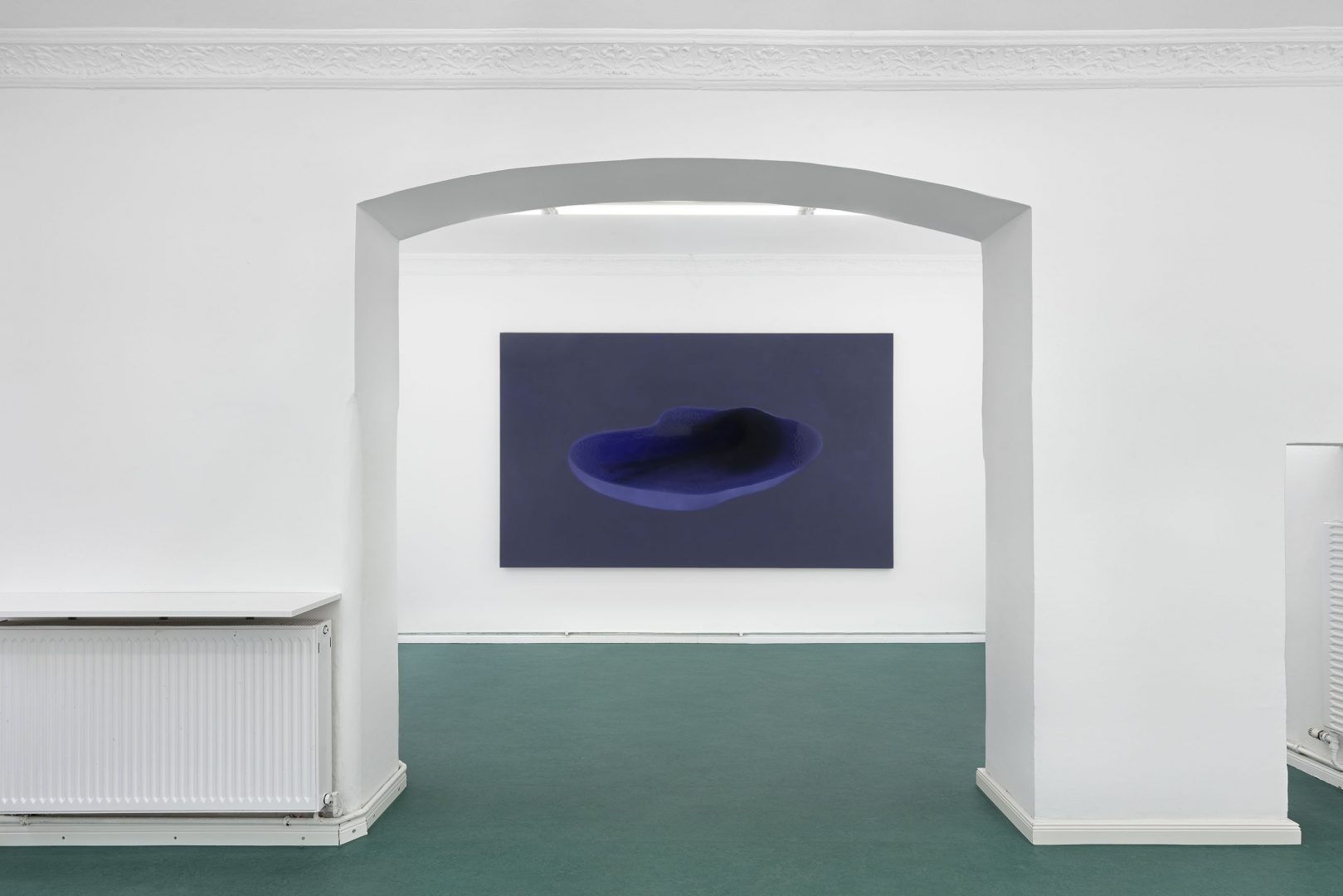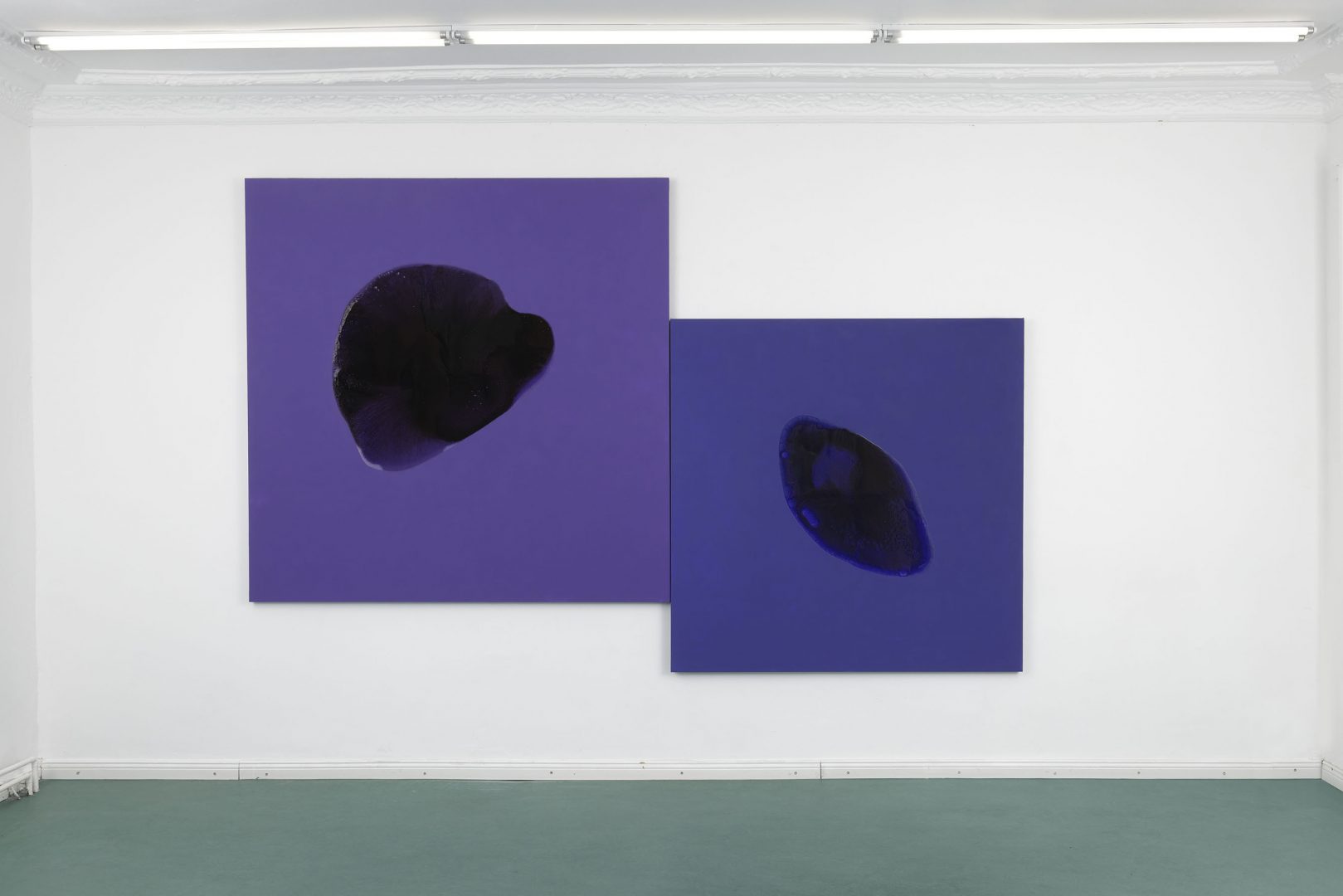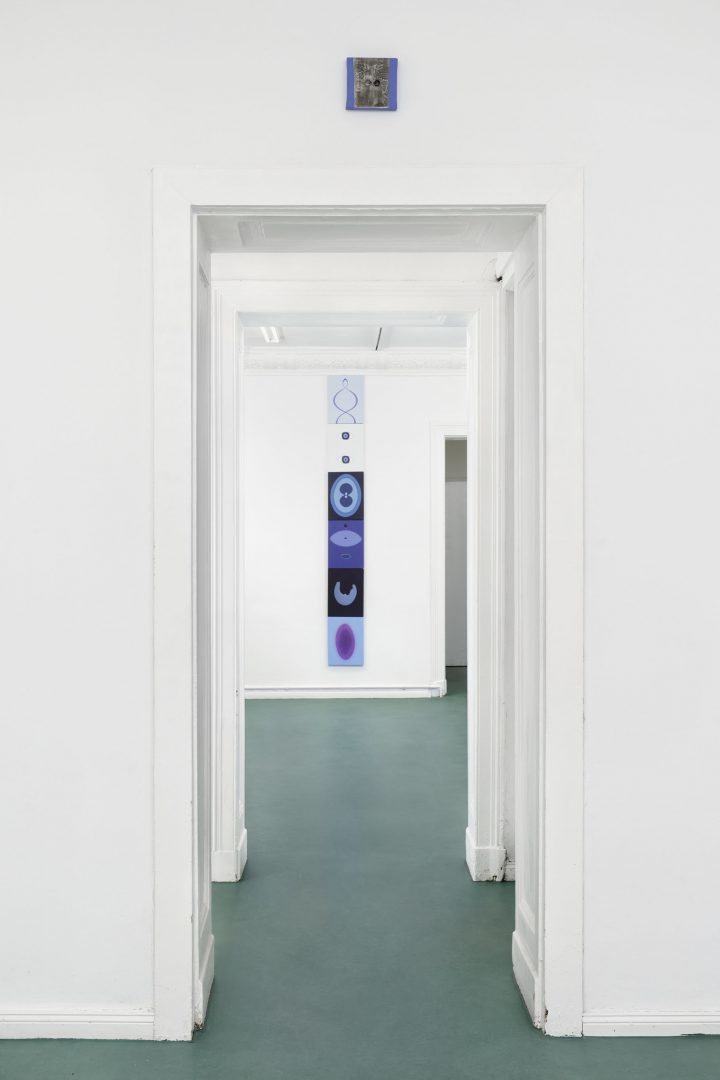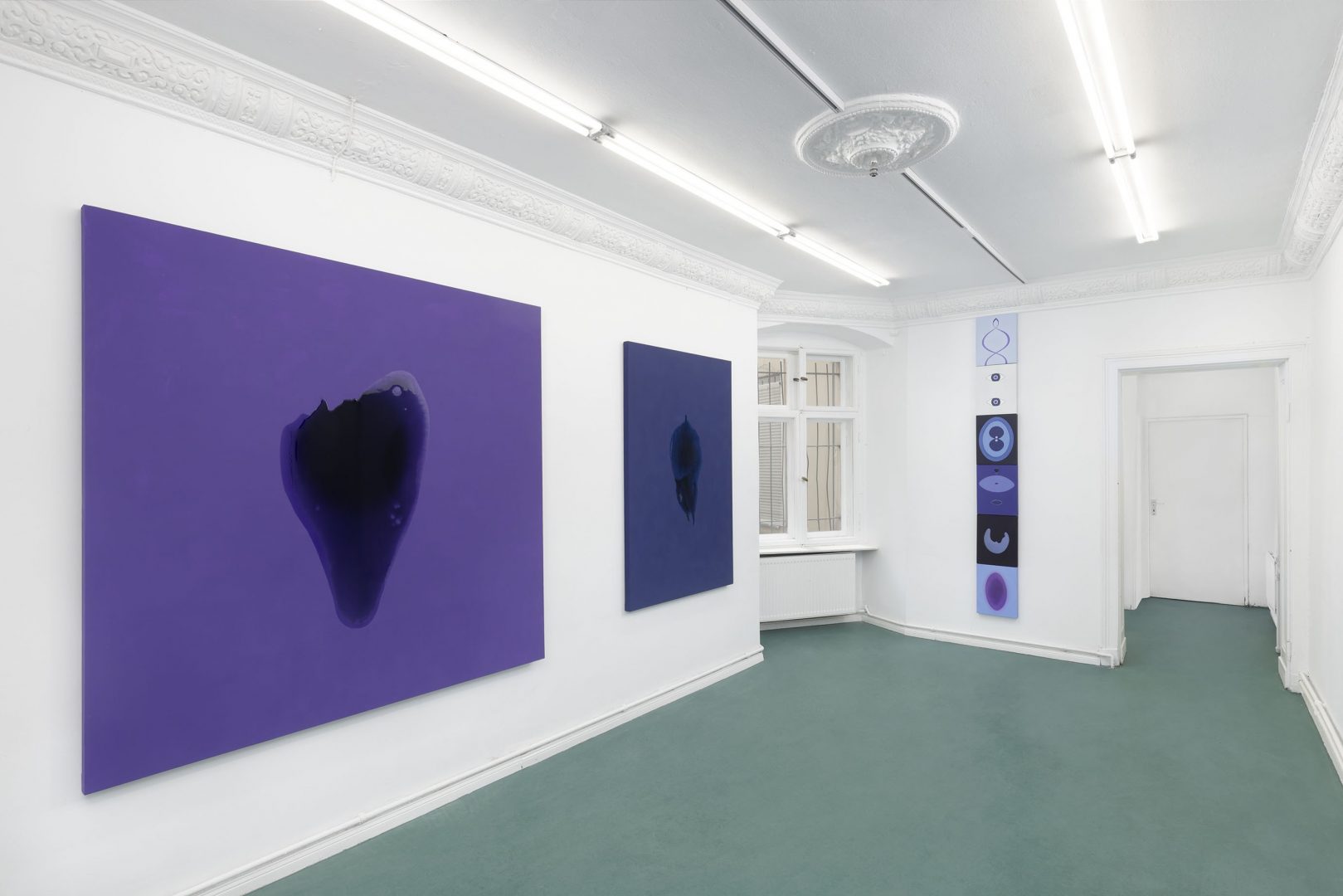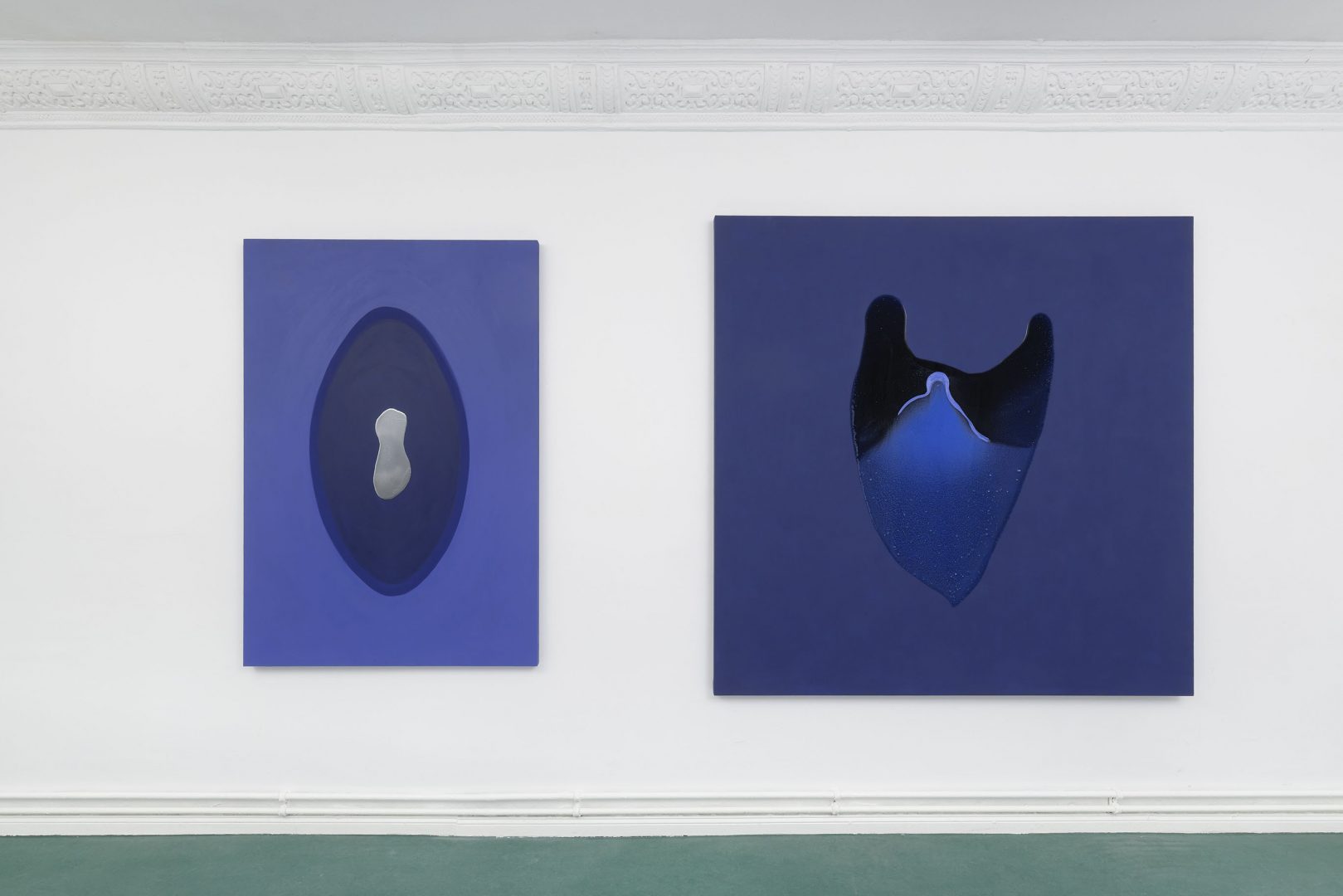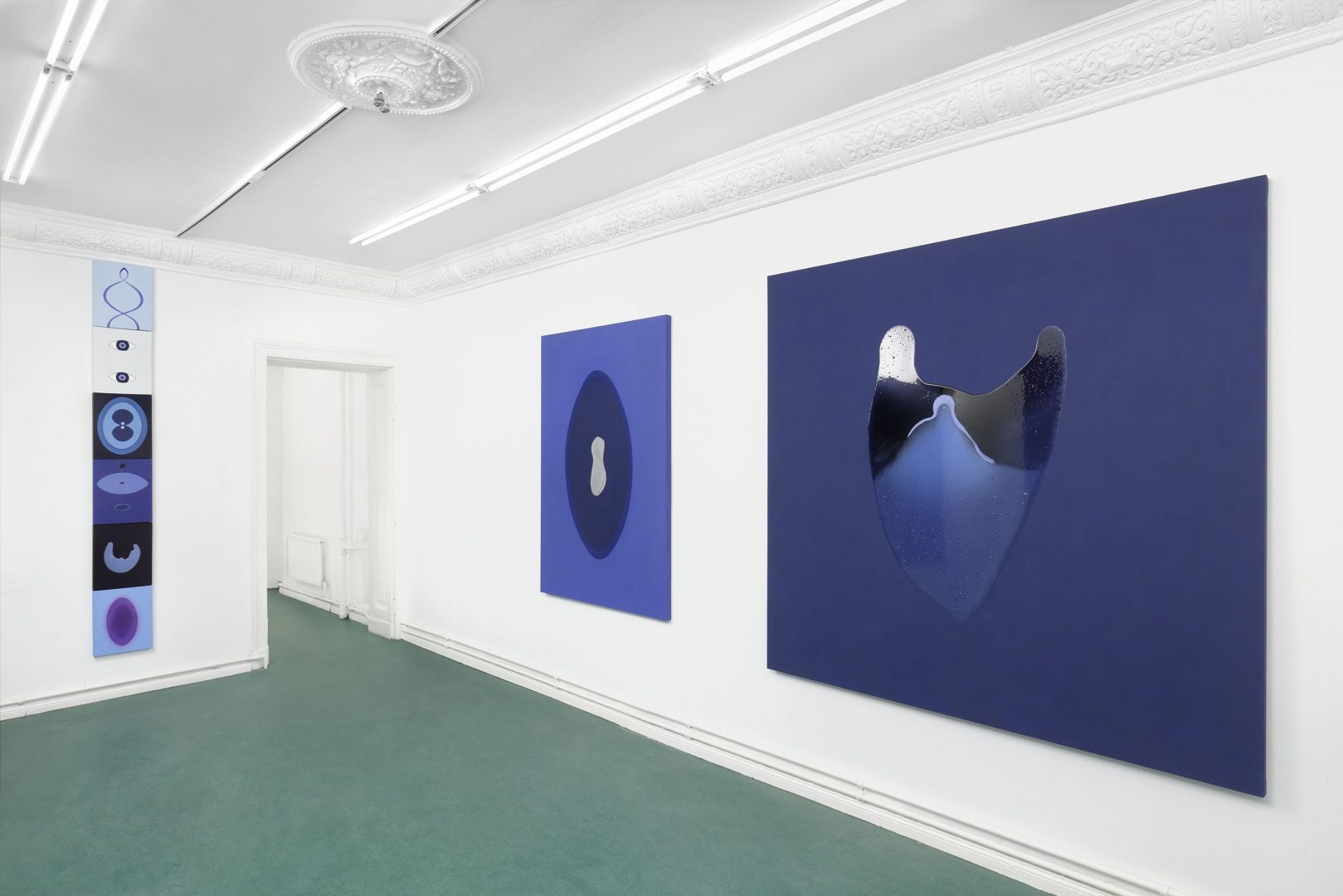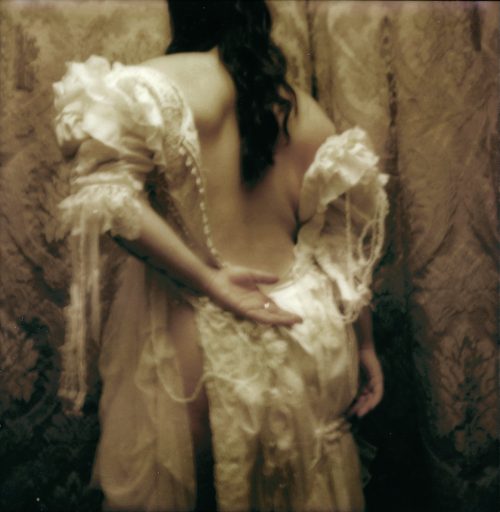
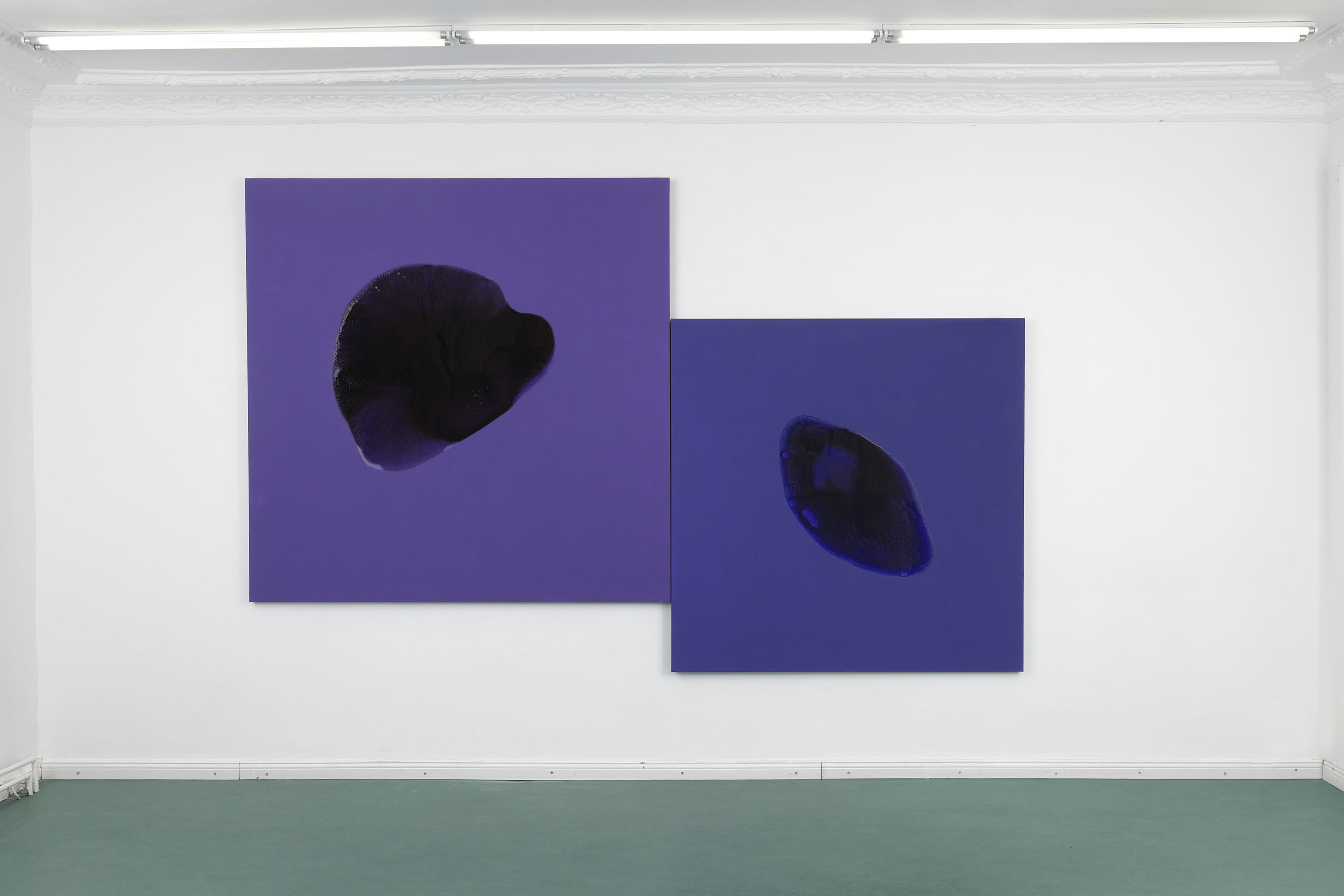
Kami Mierzvvinsk – Where the Night Softens
Project Info
- 🖤 Kami Mierzvvinsk
- 💙Galerie Noah Klink
- 🤍 13.03. – 13.04.2025
- 💜 Johanna Marie Siegler
Share on
Peripheries of Articulation, In the Mouth of the Night
Must what is seen always be known? Must what is known always be legible?
Lining the white gallery walls of Galerie Noah Klink, the mesmeric canvases of Kami Mierzvvinsk’s Where the Night Softens, the Polish artist’s first solo exhibition in Berlin, initially resemble a cabinet of oversized Rorschach tests. Executed in layered oil, ink, and epoxy resin on linen and wood, the works (most dated 2024) hover between painterly and sculptural impulses. As if conjured by optical illusion, their deep, slippery nuclei seem to swell the further one steps away – a reverse perspective that disorients spatial logic. The viewer’s first impulse is to decode the looming, tentative forms:
cells parting,
the cloudy meniscus of cooled oil,
a word forgotten but still warm in the mouth,
the glistening, tendrilled pod of a shark egg found in wet, dark sand.
Upon entering, two large-scale monochromes are installed along the right-hand wall in offset alignment – their shared palette and analogous forms setting up a delicate spatial tension. The painting on the left, titled PE.MBB (2024) commanding in its size, bears a dark, fluidly amorphous form that surges from the subdued surface. Suffused with the near-black color of bruised fruit, it proposes a gravitational center around which the painting’s energy coalesces. To its right, a slightly smaller panel (PE.0, 2024) echoes this formal motif with a similar yet distinct organic shape. Glistening with an aqueous sheen, veins of muted indigo seeming to drift within the semi translucent field, its interior complexity invites closer scrutiny. The juxtaposition of these two canvases produces a certain perceptual meshing: the smaller work’s relative translucency and fragility act as a counterweight to the denser, more absorptive presence of its neighbour. Their slight misalignment emphasizes a relational dynamic of echo and divergence.
In the adjoining, opposite room, a single canvas, the 2024 K, draws the eye with its isolated presence. The form hovers in the monochromatic visual field like a unicellular organism magnified beyond recognition. A crossbreed between deep-sea jelly, cracked egg, and leaking slash, its anatomy appears softly directed, moving with intention but without urgency. Faintly inked with the lunar bloom of bioluminescence, a wilted crescent contour cradles its underbelly.
This multiform element – unfathomable and abstrusely stirring – gestures towards, without declaring, the internal mechanics of Mierzvvinsk’s painterly logic. As a queer, interdisciplinary visual artist and performer, they focalize themes of spirituality, identity, and the fluidity of the human spirit, drawing upon the concept of anamnesis – the recollection of a pre-corporeal and pre-linguistic, intuitive knowledge – as the conceptual and affective catalyst that animates their paintings. Rather than being dissected as subject matter, this perceptual modus is integrated as an energetic undercurrent, translated into the formal logic of layered translucencies and the counterpoised movements between emergence and dissolution we trace on the surfaces of Mierzvvinsk’s monochromes. They approach painting as a performative process of gradual transformation, unfolding over extended durations and erring toward the sculptural. Through gestures enacted by the artist’s body, surfaces are slowly built up in translucent layers of oil, ink, and epoxy resin – each stratum a response to the last. Within a practice less concerned with image-making than with tending to and attuning these material and physical states in what Mierzvvinsk themselves terms an “alchemical process,” it appears as if the affective residuum of the performative act stays suspended within the layers of resin.
It is through this quiet intensity that the gallery itself takes shape as a sequence of contemplative zones, differentiated by the distinct affective resonance of each regent painting: While the inaugural rooms invite a certain immersion, a softening of the senses, the third suggests a different mode of engagement. Above the doorframe, like a votive fragment – a miniature monochrome rendered in periwinkle and coal (TMOM, 2021-2025), its weathered surface holding two darkened nodes like twin apertures – discreetly crowns the portal, marking the passage between two settings.
Inside, a vertical sequence of six small-scale paintings punctuates the wall, employing a visual vocabulary that gestures toward the iconographic without resolving into legibility. Moving downward, the sequence, rendered in gradients of midnight blue, violet, and Mierzvvinsk’s signature hue of cool lilac, unfolds with the deliberate rhythm of a visual mantra. The uppermost forms open in a register of abstraction: entangled loops, ocular motifs, glyphs untethered to grammar (RITD, NE.ADBU, OBT.TBO, in order, all 2025). Yet as the gaze descends, the compositions become increasingly formless, as though the language of the spiritual diagram gradually gives way to a more somatic syntax (OPBW, MP(AW), ITTOD (WSDW, in order, all 2025). Ovals unfurl to become voids, eyes disassemble, silhouettes curl and thicken – and by the final panel, a soft, biomorphic form glows against the blue ground with deep-violet refulgence. Its ovoid shape recalls the ‘Shiva-lingam,’ or ‘Shiva-egg,’ a central aniconic motif in Tantric painting signifying an infinite, formless presence, and the unmanifest divine. A non-figural vessel, the lingam gestures toward a pre-iconographic, ungendered generativity, making it especially resonant with the queer metaphysics that courses through Mierzvvinsk’s practice, imagining the divine not as authority, but as diffuse and radically uncontained. This slow descent toward the ovoid is not merely visual, but architectural, as the vertical stack recalls not only spiritualist diagrams but the upright geometry of the human body as a vessel for the spirit, which Mierzvvinsk understands as a fluid, genderless essence.
Where the precedent rooms offer a field of enveloping affect, the latter, presenting the visitor with a quasi-devotional interface, invites cognitive, almost ceremonial engagement. The coexistence of these two environments establishes a dialectic of concentration and dispersion, prompting us to navigate them as though passing through successive stages of perceptual and symbolic development. Yet, the fluidity of movement between these zones ensures that their distinctions are never absolute, instead affirming the gentle slipstream of the transitional.
There is a distinctly queer temporal logic at play in Kami Mierzvvinsk’s work. As José Esteban Muñoz writes in Cruising Utopia, queerness is not a state but a horizon – “an ideality that can be distilled from the past and used to imagine a future.” The nocturnal space Mierzvvinsk constructs in Where the Night Softens quietly awaits this horizon while growing attuned to the in-between. Then, the question of legibility and the articulation of what is seen stays suspended within the very same stratum of the not-yet: To paint here, in the mouth of the night, within and against the historical monochrome, is to evade retinal certainty in favor of a different kind of seeing that pauses at the peripheries of language, summoning and disrupting what Gestalt theorists have long identified as the mind’s tendency to seek resolution in form. We see, but cannot quite place; we remember, but without referent. Even the titles, abbreviated strings like PE.0 or ITTOD (WSDW), read less as names or indexes than as semantically unanchored coordinates, reinforcing Mierzvvinsk’s preference for systems that privilege dispersion, eluding eidetic memory for an intimate attempt at affective absorption and private associative logics.
We are left in that dim threshold before the eyes adjust to darkness, where everything appears to dematerialize for a brief moment, as the tide tugs at a glinting pod and our tongue curls around something warm, saline and shapeless.
